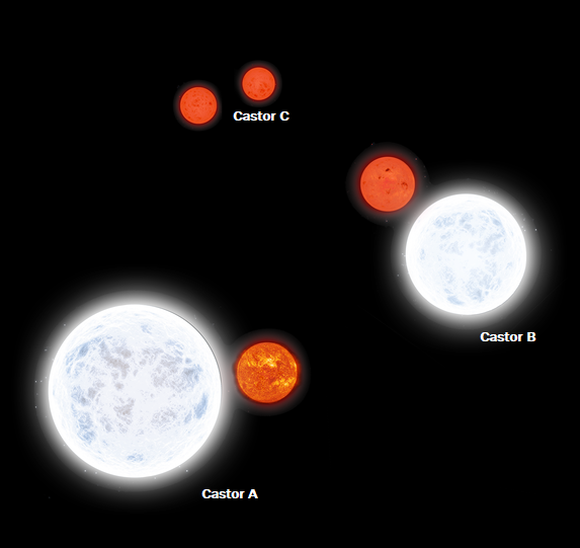Early April offers up an interesting stellar observing challenge for all skill levels of 'star gazers', whether they are casual, novice or seasoned astronomers. Unlike the 'Messier marathon', which can be a marathon in terms of observer’s time - hunting down deep sky (and not so deep) objects associated with the Messier catalogue over a span of many hours, this challenge is relatively simple and may be accomplished in just a few minutes. Less a marathon - more a sprint really!
The challenge involves spotting first magnitude stars, those stars ranked amongst the brightest in the sky. Sounds easy, well, it can be. Dotted around the twilight sky of early spring from northern temperate latitudes, no fewer than 13 first magnitude stars, more than at any other time of year, are visible at the same time. But as evenings grow lighter, can you spot and identify these stellar jewels? It isn't all plain sailing though, the weather can intervene and the window of opportunity in which to identify these stars rapidly diminishes as we head deeper into April, from little over an hour at the start, to under fifteen minutes by mid-month.
Although no visual aids are required; you don't require binoculars or a telescope, there is one observing requirement, an almost complete 360-degree unobstructed view of the horizon. There may also be other complicating factors to be mindful of, normally in the guise of planets and for April 2023 three may cause confusion. The dazzling presence of Venus, should be obvious, outshining all, but Mercury is also visible low in the WNW for the first couple of weeks in April until after 21:00hrs. Mars is also visible to the naked eye, but higher in the west (above Venus) and may be confused with one of our stars.
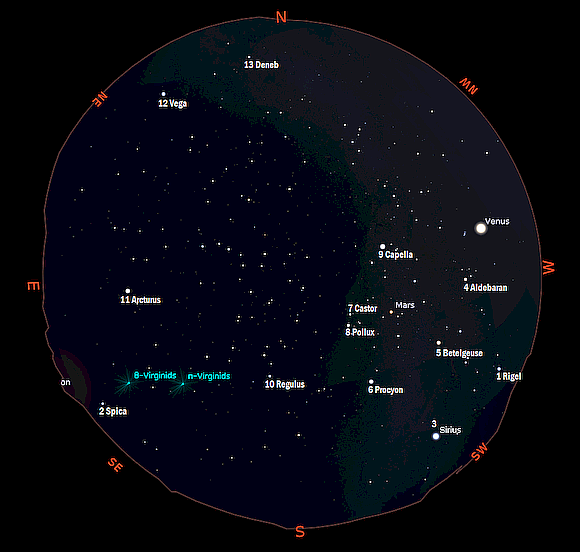
3-Minute Stellar Baker's Dozen Challenge of 1st Magnitude Stars (by Mark Dawson)
Click for full-size image with Key.
Of the 13 first magnitude stars visible, I will say right now that one is an imposter, not 1st magnitude at all, but is almost universally considered as one due to its location (more on that shortly). Two of the stars are comparatively close by - within a dozen light years. Three are orange giant or supergiant stars and three will eventually become supernova - quite a high proportion from our candidates.
Having chosen your observing site, all that is needed is a clear evening. Let us assume it is early April, at which time twilight deepens around 21:00hrs BST from the UK. Our first port of call lies over in the west, where the mighty hunter; Orion, is about to lose his right toe, marked by bright Rigel, (1) below the horizon. Rigel is the 5th brightest star visible from UK shores shining with an apparent magnitude of 0.12. It is a blue supergiant of spectral class B8 at least 18 times more massive and upwards of 100,000 times more luminous than our Sun. It is considered the most luminous star within 1000 light years and is a definite supernova candidate in several million years’ time. A triple star system accompanies Rigel through space orbiting 2000 AU from Rigel. Rigel is located around 900 light years away.
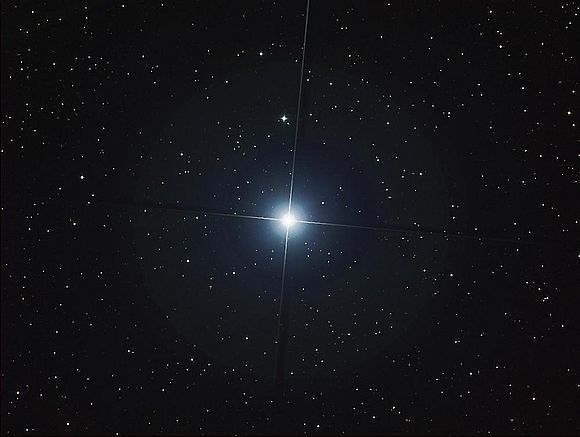
The brightest star in Orion - Rigel
Above Rigel in the sky, Orion’s three belt stars are aligned parallel to the west horizon, but the next star on our list is almost opposite Rigel in the sky, so you need to spin round and face SE. Spica (2), along with Rigel is perhaps the crux of the challenge, the ability to spot Spica, chief star in Virgo, just rising in the SE and Rigel above the horizon at the same time. Spica (mag 0.98) is a rapidly spinning B1 class star some 22,000 degrees K in temperature making it the hottest star of our collection. Spica is over 2000 times more luminous than our Sun and has a spectroscopic binary companion. They lie over 260 light years away.

Spica in Virgo - the hottest of the dozen
We now turn to the brightest star in the night sky, Sirius (3) sparkling away low in the WSW. Sirius in Canis Major is of course the brightest star in our night sky (mag - 1.46), and although slighter more massive and luminous than our Sun, its brilliance is chiefly down to its proximity, just 8.6 light years distant, making it closest of the stars on our list. The ‘Dog Star’ is the second least powerful star of the baker’s dozen, Procyon in the lesser dog of Canis Minor holding that title. Sirius has a spectral class of A1 with a surface temp of 10k. It is accompanied in space by the ‘pup’ or Sirius B, a small white dwarf star, some 26,000 miles in diameter and 1/10000 the luminosity of Sirius A.

Sirius and Sirius B - the 'Pup'
Back to the WNW and look for the orange hue of Aldebaran (4) 'the eye of the bull' in the Hyades - the arrowhead cluster in Taurus. Aldebaran is a K5 class orange/red giant star with a diameter of over 35 million miles. Having a visual mag of 0.85, Aldebaran lies approx. 68 light years away, half the distance of the true Hyades members against which it sits in the sky. Aldebaran was the first star recognised as having a proper motion in space by Sir Edmond Halley in the 18th century – when he realised Aldebaran could not have been occulted by the Moon in 509AD unless it had moved slightly in space.
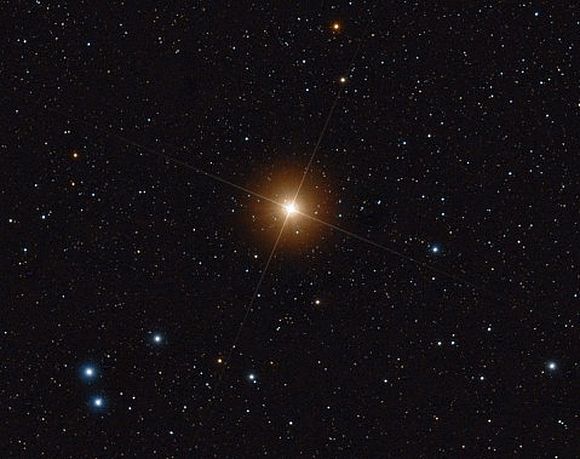
The 'Eye of the Bull'- Aldebaran - in Taurus
From a giant star to a supergiant, Betelgeuse, sitting above the belt stars of Orion. Betelgeux (alternative spelling) is a class M2 red supergiant star of gargantuan proportions and 15,000 times more luminous than our Sun. It is intrinsically variable (0.1 - 0.9) but has been known to fade further - as was the case from October 2019, when Betelgeuse began to dim noticeably, and by mid-February 2020 its brightness had dropped by a factor of approximately 3, from magnitude 0.5 to 1.7 before it returned to a more normal brightness range. A study using the HST suggests that occluding dust was created by a surface mass ejection. The material cast off then cooled to form the dust that caused the star's dimming. Betelgeuse is one of the largest naked eye stars, perhaps 500-600 million miles in diameter, and even though 585 light years distant, has been imaged as a disk. Betelgeuse is a strong supernova candidate, but it may not be in our lifetime!
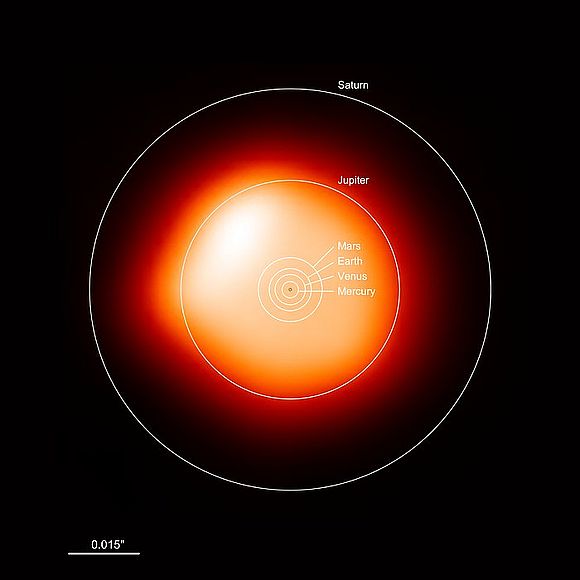
The red supergiant star Betelgeuse
Having picked out this first clutch of stars, there is no time to waste, so raise your gaze somewhat higher, to pick out the next wave of luminaries. Starting in the SW again, seek out the bright solitary white hue of Procyon (6) in Canis Minor. Like its canine neighbour - Sirius, Procyon also lies nearby - just over 11 light years away, making it the 2nd nearest and least powerful of our stars here. Procyon is one of a few bright F class stars visible to the naked eye. This equates to a surface temperature of around 7200 degrees K. Strangely like Sirius, Procyon also has a white dwarf companion star. The apparent magnitude is 0.34 making it the 6th brightest of the stars on the list.
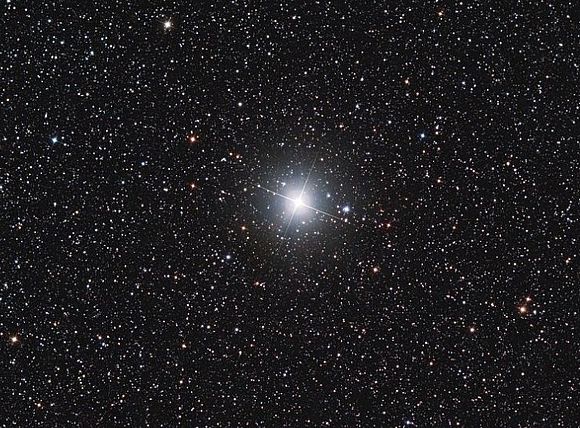
The 'lesser' dog star - Procyon in Canis Minor
Due West and higher still, our next two stars represent the Twins - Gemini, descending feet first toward the WNW horizon. Castor (7) appears as a single white A0 class star to the naked eye, but is in reality a sextuplet, two of which may be split with a modest telescope at medium power.
Castor is a good indication of how good atmospheric seeing is, if you cannot separate them well, it’s poor seeing. Castor is located 46 light years away and has a visual magnitude of 1.58, making Castor the imposter here, just outside the top ranked stars in terms of apparent magnitude. Its proximity to fellow twin Pollux, which is of amber hue, can trick the brain into thinking Castor is as bright as Pollux. But we shall include Castor, 13 is a lucky number in many countries. Pollux is a K0 spectral class star 36 light years or so distant. It is 60 times more luminous than the Sun and further down the evolutionary road, becoming an orange giant star and is already over 4 million miles in diameter. Pollux is brighter by half a magnitude than Castor. Mars lies in the vicinity of Pollux, and is definitely an imposter!

Pollux (bottom) with Castor above - the Twins. Image credit Greg Parker
High to the WNW Capella shines brilliant Capella (9) in Auriga - the Charioteer. It is the only one of our bright seasonal winter stars not to set, being circumpolar from our latitude. Capella will spend the summer months arcing low above the north horizon and tricking the unwary into thinking it's the north star! At mag 0.08 is really a very close binary star of G8 and F0 class components separated by just 70 million miles. Of the stars north of the celestial equator, Capella is only outranked by Arcturus and Vega.
Due South, midway up, you will encounter bright Regulus (10) in the ‘sickle’ asterism of Leo. Regulus sits almost directly on the celestial equator and as such can be occulted by Sun, Moon and occasionally, planets. Regulus was counted as one of the 'Royal Stars' - regarded as the guardians of the sky during the time of the Persian Empire (550 BC–330 BC) the others were Aldebaran, Antares and Fomalhaut. Regulus (mag 1.38) appears singular but is really a quadruple system composed of four stars organized into two pairs. Regulus A consists of a blue-white star and its companion, which has not yet been directly observed, is probably a white dwarf. Regulus A, like Spica, is rotating extremely quickly - just 16 hours for one rotation and will appear 'rugby ball' shaped! The system lies approximately 79 light years away.

The Regulus star system
Our next luminary is located due east, brilliant Arcturus (11) in the constellation of Bootes. The soft orange hue contrasts markedly with Sirius, the only star of the baker’s dozen brighter. Arcturus is a K2 class orange giant star, the closest of that type to our Sun at 36 light years. It has a diameter exceeding 20 million miles (32m Km) and is a solitary traveller through space having one of the largest proper motions (real movement against background stars) of any bright star at 56 miles per second - in the direction of Virgo. Now, for a test within a challenge, see how far into April you can spot both Sirius and Arcturus above the horizon at the same time!

Arcturus - 'guardian of the bear' in Bootes the Herdsman
So, having viewed west, south, and east, direct your gaze toward the North, where low in the North-East brilliant steely blue Vega (12) resides in the constellation of Lyra. Vega has a lovely steely-blue colour and is a gorgeous sight in a telescope. It resides 26 light years away and although considered 'young' at 'just' 450 million years old, is already halfway through its life cycle, being over double our Sun's mass. Vega almost rivals Arcturus in apparent magnitude, but unlike the ‘guardian of the bear”, it is circumpolar from the latitude of the UK.
Our final star, Deneb (13) is located just above the NNE horizon and appears much less brilliant than Vega but is by far the most distant (1800 light years) and perhaps the most massive of the stars visited, it certainly rivals Rigel. Deneb has an apparent magnitude of 1.25, but an absolute mag of -7.5. It is the third supernova candidate on our list but is classed as an A2 star and has not yet evolved to become a red supergiant, that will be a few million years down the line when our night skies will look very different indeed!

Deneb - in Cyguns - the ticking time bomb
There we have it, thirteen 1st magnitude stars (almost) visible at the same time. The test shouldn’t take more than a few minutes to spot them, but timing is crucial and being able to spot Spica, Rigel and Sirius at the same time is the key to accomplishing the task. Good Luck and clear skies.
- Log in to post comments


